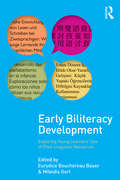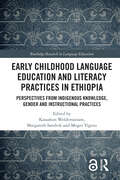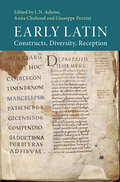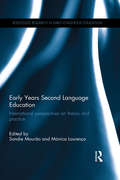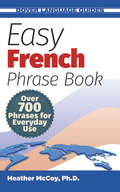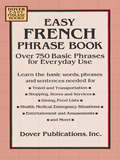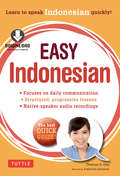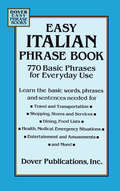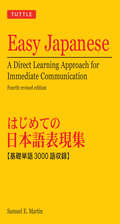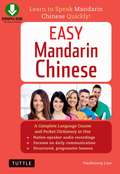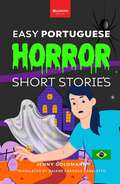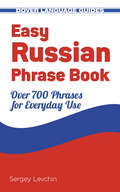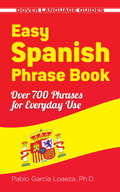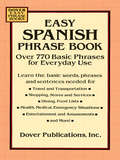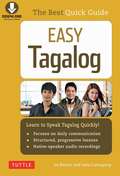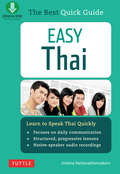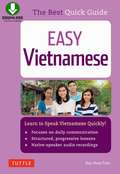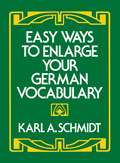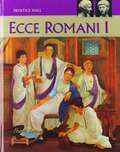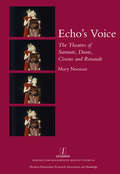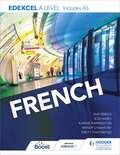- Table View
- List View
Early Biliteracy Development: Exploring Young Learners' Use of Their Linguistic Resources
by Eurydice Bouchereau Bauer Mileidis GortA large and growing number of students from culturally and linguistically diverse backgrounds in the US and around the world have the potential to develop bilingualism and biliteracy if supported in their immediate environment. At the forefront in focusing exclusively on biliteracy development in early childhood across a variety of languages, this book provides both findings from empirical research with young bilinguals in home and school contexts and practical applications of these findings. Each chapter is structured in a similar format to offer parallel descriptions of the research, including a brief review of related empirical studies, an overview of the methods for data collection and analysis, a description of the main findings, and specific pedagogical implications to support educators’ efforts to construct meaningful, challenging, and dynamic literacy and language learning communities where one or more languages are used for communicating and learning. Pushing the field forward, this book is a valuable resource for helping literacy educators understand and respond to critical issues related to the development of young children’s literate competencies in two languages in home and school contexts.
Early Childhood Language Education and Literacy Practices in Ethiopia: Perspectives from Indigenous Knowledge, Gender and Instructional Practices (Routledge Research in Language Education)
by Kassahun Weldemariam Margareth Sandvik Moges YigezuThis edited volume explores how indigenous knowledges and practices can be instrumental in improving literacy outcomes and teacher development practices in Ethiopia, aiding children’s long-term reading, and learning outcomes. The chapters present research from a collaborative project between Ethiopia and Norway and demonstrate how students can be supported to think pragmatically, learn critically and be in possession of the citizenship skills necessary to thrive in a multilingual world. The authors celebrate multilingualism and bring indigenous traditions such as oracy, storytelling, folktales to the fore revealing their positive impact on educational attainment. Addressing issues of language diversity and systematic ignorance of indigenous literacy practices, the book plays a necessary role in introducing Ethiopia’s cultural heritage to the West and, hence, bridges the cultural gaps between the global north and global south. Arguably contributing one of the first publications on early literacy in Ethiopian languages, this book will appeal to scholars, researchers and postgraduate students studying the fields of early years literacy and language, indigenous knowledge and applied linguistics more broadly.
Early Latin: Constructs, Diversity, Reception
by Anna Chahoud J. N. Adams Giuseppe Pezzini Charlie KerriganThis is the most detailed and comprehensive study to date of early Latin language, literary and non-literary, featuring twenty-nine chapters by an international team of scholars. 'Early Latin' is interpreted liberally as extending from the period of early inscriptions through to the first quarter of the first century BC. Classical Latin features significantly in the volume, although in a restricted sense. In the classical period there were writers who imitated the Latin of an earlier age, and there were also interpreters of early Latin. Later authors and views on early Latin language are also examined as some of these are relevant to the establishment of the text of earlier writers. A major aim of the book is to define linguistic features of different literary genres, and to address problems such as the limits of periodisation and the definition of the very concept of 'early Latin'.
Early Years Second Language Education: International perspectives on theory and practice (Routledge Research in Early Childhood Education)
by Mónica Lourenço Sandie MourãoThe age for early language learning has dropped dramatically in the past decade to include children under 6 years old, yet very little published research exists to support the implementation of such programmes. Drawing on a synthesis of theory, research and practice, this edited volume makes an innovative contribution to literature concerning language education for very young children. It explores language learning in a wide range of geographical contexts with reference to second and foreign language learning, bilingualism and plurilingualism with children under the age of 6 years old. Chapters present discussion around teacher education, policy-making, international case studies, school and home-based projects, code switching and language use, and methodologies and approaches. Early Years Second Language Education: International perspectives on theory and practice will be essential reading for researchers, academics, teacher trainers, and post-graduate students in the fields of early years education, foreign and second language education, language didactics and teacher education.
Early and Late Latin
by James Adams Nigel Vincent Valerie KnightThis book addresses the question of whether there are continuities in Latin spanning the period from the early Republic through to the Romance languages. It is often maintained that various usages admitted by early comedy were rejected later by the literary language but continued in speech, to resurface centuries later in the written record (and in Romance). Are certain similarities between early and late Latin all that they seem, or might they be superficial, reflecting different phenomena at different periods? Most of the chapters, on numerous syntactic and other topics and using different methodologies, have a long chronological range. All attempt to identify patterns of change that might undermine any theory of submerged continuity. The patterns found are summarised in a concluding chapter. The volume addresses classicists with an interest in any of the different periods of Latin, and Romance linguists.
Easy French Phrase Book NEW EDITION: Over 700 Phrases for Everyday Use (Dover Language Guides French)
by Heather MccoyHere's the perfect companion for tourists and business travelers in France and other French-speaking locales. With more than 700 French phrases and sentences, this book offers fast, effective communications for everyday situations that range from asking directions and renting a car to ordering dinner and finding an ATM.An easy study guide as well as a handy reference, this user-friendly book features completely up-to-date terms for modern telecommunications. Contents are arranged for quick access to phrases related to greetings, transportation, shopping, medical and emergency situations, and other common circumstances. A phonetic pronunciation accompanies each phrase.
Easy French Phrase Book: Over 750 Phrases for Everyday Use (Dover Language Guides French)
by DoverHere's the perfect book to use when you're traveling to France, Belgium, and other French-speaking areas for business or pleasure -- or whenever fast, effective communication in French is needed.This handy, sturdy volume contains more than 750 basic words and phrases that provide the practical language necessary for most everyday situations. Designed for use as a quick reference tool and an easy study guide, Easy French Phrase Book is the perfect companion when traveling abroad or for reading at odd moments in order to learn a few phrases each day.Included are basic phrases used in: making yourself understood; general expressions; restaurants and specialty shops; phone conversations; boat, plane, and train travel; making hotel reservations; and much more. Each phrase in this inexpensive and easy-to-use book is accompanied by a phonetic pronunciation guide, and a complete index makes word and phrase location quick and easy.
Easy Indonesian: : Learn To Speak Indonesian Quickly
by Thomas G. Oey Katherine DavidsenIndonesia is the hot new Asian destination, a country where lively conversation, good humor and warm human interaction are integral parts of daily life. Easy Indonesian brings the language and culture of Indonesia alive, giving you all the basics you need to start speaking Indonesian immediately. The opening chapters introduce the essentials of pronunciation and sentence construction, with each subsequent chapter moving you forward in gradually building up your knowledge for specific situations and activities, such as making new acquaintances, going shopping, traveling around, and much more. Every chapter contains helpful information on the customs and culture of this warm and friendly country, so that you'll soon be able to talk about everything from the weather to your job and home and family with ease. An extensive glossary at the back and a section on verb and noun forms are included to help you build your vocabulary and understand the different forms that Indonesian words take
Easy Italian Phrase Book: 770 Basic Phrases for Everyday Use (Dover Language Guides Italian)
by DoverHere's the perfect book to use when you're traveling to Italy for business or pleasure -- or whenever fast, effective communication in Italian is needed.This handy, sturdy volume contains more than 770 basic phrases that provide the practical language necessary for most everyday situations. Designed for use as a quick reference tool and an easy study guide, Easy Italian Phrase Book is the perfect companion when traveling abroad or for reading at odd moments in order to learn a few phrases each day.Included are basic phrases used in: making yourself understood; general expressions; restaurants and specialty shops; phone conversations; boat, plane, and train travel; making hotel reservations; and much more. Each phrase in this inexpensive and easy-to-use book is accompanied by a phonetic pronunciation guide, and a complete index makes word and phrase location quick and easy.
Easy Japanese
by Samuel E. MartinThis is a carefully structured, practical book for learning colloquial spoken Japanese.Each lesson presents a few of the most common features of the language in sentences which are short, easy, and immediately useful. The first thirteen lessons show you there is a lot that can be said with just a word or two. The later lessons introduce more variety and explain a few of the fine points. The sentences reflect how the Japanese language is really spoken. They are short but colloquial, abrupt but not rude. Each lesson contains first a number a number of Japanese phrases followed by material for practice. These are short conversations mad up entirely of the phrases you have learned in the lesson (or in preceding lessons).After the lessons, there is a basic vocabulary of some common Japanese words and their English equivalents. The Japanese verbs are presented both in the polite present (-mas') and the plain resent (-u or -ru). At the end of the book there are indexes of Japanese hiragana and katakana. Key highlights of this book are:30 short, easy-to-follow lessons with practical exercisesA Japanese-English dictionary of over 3,000 most commonly used wordsWriting charts of the hiragana and katakana Japanese syllabaries.
Easy Japanese
by Samuel E. MartinThis is a carefully structured, practical book for learning colloquial spoken Japanese.Each lesson presents a few of the most common features of the language in sentences which are short, easy, and immediately useful. The first thirteen lessons show you there is a lot that can be said with just a word or two. The later lessons introduce more variety and explain a few of the fine points. The sentences reflect how the Japanese language is really spoken. They are short but colloquial, abrupt but not rude. Each lesson contains first a number a number of Japanese phrases followed by material for practice. These are short conversations mad up entirely of the phrases you have learned in the lesson (or in preceding lessons).After the lessons, there is a basic vocabulary of some common Japanese words and their English equivalents. The Japanese verbs are presented both in the polite present (-mas') and the plain resent (-u or -ru). At the end of the book there are indexes of Japanese hiragana and katakana. Key highlights of this book are:30 short, easy-to-follow lessons with practical exercisesA Japanese-English dictionary of over 3,000 most commonly used wordsWriting charts of the hiragana and katakana Japanese syllabaries.
Easy Mandarin Chinese: Learn to Speak Mandarin Chinese Quickly! (Downloadable Audio Included)
by Haohsiang LiaoConcise and user-friendly, Easy Mandarin Chinese is designed for anyone who wants to learn Mandarin Chinese--whether on their own or with a teacher.This language learning book introduces the learner to all the basics of the Chinese language and teaches practical daily conversations and vocabulary. It enables users to begin communicating effectively from the very first day and it's compact size makes it a great tool for travelers or business people looking to learn Chinese on the road without giving up on any content.This Mandarin language learning book includes: Useful notes on the Chinese script, pronunciation, sentence structure, vocabulary, and grammar Sections covering greetings, requests, idiomatic expressions and common situations Cultural information about Chinese etiquette as well as do's and don'ts A glossary of the most commonly-used Mandarin Chinese words and phrases Downloadable audio with many hours of native-speaker recordings of the dialogues, vocabulary and exercises.
Easy Portuguese Horror Short Stories: Learn Portuguese the Spooky Way!
by Jenny Goldmann"Aprenda Português do Jeito Assustador!" Você se atreve a percorrer as trilhas assombradas do ensino de Português? Nestas páginas, há uma coleção de 9 histórias de terror fáceis em Português, cada uma criada para entreter e educar. Junte-se a guias fantasmagóricos e enfrente provações de outro mundo enquanto aprimora seu vocabulário, compreensão e habilidades de conversação. Projetadas especificamente para alunos de Português no nível A2-B1/2, essas histórias assustadoras oferecem mais do que apenas sustos. Testes, glossários e perguntas para discussão esperam por você, tornando essa jornada rumo ao desconhecido tão emocionante quanto gratificante. •9 Histórias envolventes: explore diversos temas de terror em contos criados para intrigar e desafiar, mas adequados para todas as idades. •Aprenda em seu nível: escrito para alunos A2-B1/2, garantindo vocabulário e gramática acessíveis. As histórias aumentam em dificuldade, o que significa que os alunos podem ter uma noção do avanço até o final do livro. •Ferramentas educacionais: glossários, questionários de múltipla escolha e perguntas para discussão apoiam a compreensão e incentivam as conversas. Seja você um professor de idiomas em busca de material novo ou um autodidata em busca de uma forma aventureira de aprimorar suas habilidades em Português, “Easy Portuguese Horror Stories” oferece uma experiência emocionante e educativa. Adquira seu exemplar hoje mesmo e desvende os mistérios da língua Portuguesa - se tiver coragem!
Easy Russian Phrase Book NEW EDITION: Over 700 Phrases for Everyday Use (Dover Language Guides Russian)
by Sergey LevchinDesigned as a quick reference tool and an easy-to-use study guide, this inexpensive and up-to-date book offers fast, effective communications. The perfect companion for tourists and business travelers in Russia, it features words, phrases, and sentences that cover everything from asking directions to ordering dinner.Over 700 conveniently organized expressions include terms for modern telecommunications as well as phrases related to transportation, shopping, medical and emergency situations, and other common circumstances. A phonetic pronunciation accompanies each phrase.
Easy Russian Phrase Book: Over 690 Basic Phrases for Everyday Use (Dover Language Guides Russian)
by DoverHere's the perfect book to use when you're traveling to Russian-speaking areas for business or pleasure -- or whenever fast, effective communication in Russian is needed.This handy, sturdy volume contains more than 700 basic words and phrases that provide the practical language necessary for most everyday situations. Designed for use as a quick reference tool and an easy study guide, Easy Russian Phrase Book is the perfect companion when traveling abroad or for reading at odd moments in order to learn a few phrases each day.Included are basic phrases used in: making yourself understood; general expressions; restaurants and specialty shops; phone conversations; boat, plane, and train travel; making hotel reservations; and much more. Each phrase in this inexpensive and easy-to-use book is accompanied by a phonetic pronunciation guide, and a complete index makes word and phrase location quick and easy.
Easy Spanish Phrase Book NEW EDITION: Over 700 Phrases for Everyday Use (Dover Language Guides Spanish)
by Dr Pablo Garcia LoaezaDesigned as a quick reference tool and an easy-to-use study guide, this inexpensive and up-to-date book offers fast, effective communications. The perfect companion for tourists and business travelers in Spain and Latin America, it features words, phrases, and sentences that cover everything from asking directions to ordering dinner.Over 700 conveniently organized expressions include terms for modern telecommunications as well as phrases related to transportation, shopping, medical and emergency situations, and other common circumstances. A phonetic pronunciation accompanies each phrase.
Easy Spanish Phrase Book: Over 770 Basic Phrases for Everyday Use
by DoverHere's the perfect book to use when you're traveling to Spain or Latin America for business or pleasure -- or whenever fast, effective communication in Spanish is needed.This handy, sturdy volume contains more than 770 basic words and phrases that provide the practical language necessary for most everyday situations. Designed for use as a quick reference tool and an easy study guide, Easy Spanish Phrase Book is the perfect companion when traveling abroad or for reading at odd moments in order to learn a few phrases each day.Included are basic phrases used in: making yourself understood; general expressions; restaurants and specialty shops; phone conversations; boat, plane, and train travel; making hotel reservations; and much more. Each phrase in this inexpensive and easy-to-use book is accompanied by a phonetic pronunciation guide, and a complete index makes word and phrase location quick and easy.
Easy Tagalog: Learn to Speak Tagalog Quickly
by Joi Barrios Julia CamagongEasy Tagalog brings the Tagalog language and culture of the Philippines alive, giving you all the basics you need to start speaking basic Tagalog immediately. <P><P>The opening chapters introduce the essentials of Tagalog pronunciation and sentence construction, showing you how to build simple Tagalog sentences. Each subsequent chapter gives a short, easy dialogue that's useful in an everyday situation, along with a new set of sentence patterns and a vocabulary list to help you gradually build up your knowledge and repertoire for activities like making new acquaintances, going shopping, and much more. Every chapter contains helpful information on the customs and culture of this warm and friendly island nation, so that you'll soon be able to talk with ease about everything from the weather to your job and home and family. An extensive glossary at the back and a variety of interesting practice activities, with answer keys, help you build your fluency. The audio disc is a great way to learn Tagalog and gives you a solid foundation in correct pronunciation and helps you get a feel for the spoken language. Let Filipino experts Barrios and Camagong teach you how to enjoy this beautiful language.
Easy Thai
by Jintana RattanakhemakornLearn the basics of Thai quickly and easily! Easy Thai is exciting and helpful for beginning Thai Language students and anyone who needs a functional day-to-day grasp of colloquial Thai. An excellent resource to learn Thai, its twelve chapters cover practical and useful conversation topics such as introductions, telling the time, directions, ordering food and shopping. Each chapter opens with a dialogue that introduces new language in context, and contains: Vocabulary lists Grammar notes Sentence patterns Exercises Notes on culture and etiquette. All dialogues, vocabulary lists, and sentence patterns are rendered in Thai script, romanized Thai, and English. In the comprehensive, concise introduction to Easy Thai, you will understand how to pronounce, read and write the Thai language. A bilingual dictionary at the end of the book gives translations for approximately 1,000 common words in both Thai and English. An audio disc provides sample conversations by native Thai speakers, helping you to practice authentic pronunciation. Easy Thai contains everything you as a beginning language learner need to know about the basics of Thai, making you a more effective communicator from the very first lesson without having to resort to long, dull, expensive courses of study!
Easy Vietnamese: Learn to Speak Vietnamese Quickly! (Downloadable Audio Included)
by Bac Hoai Tran Sandra GujaConcise and user-friendly, Easy Vietnamese is designed for anyone who wants to learn Vietnamese--whether on their own or with a teacher.This language learning book introduces the learner to all the basics of the Vietnamese language and teaches practical daily conversations and vocabulary. It enables users to begin communicating effectively from the very first day and it's compact size makes it a great tool for travelers or business people looking to learn Vietnamese on the road without giving up on any content.This Vietnamese learning book includes: Useful notes on Vietnamese script, pronunciation, sentence structure, vocabulary, and grammar Sections covering greetings, requests, idiomatic expressions and common situations Cultural information about Vietnamese etiquette as well as do's and don'ts A glossary of the most commonly-used Vietnamese words and phrases Downloadable audio with many hours of native-speaker recordings of the dialogues, vocabulary and exercises.
Easy Ways to Enlarge Your German Vocabulary
by Karl A. SchmidtAlthough there are many books that cover German grammar and syntax, remarkably little modern attention has been given to the practical problem of acquiring a German vocabulary. Yet building up or enlarging a basic vocabulary can be one of the most time-consuming and most difficult tasks for the student, if he approaches it by the conventional method of word lists or reading notes. As the present book, by Karl A. Schmidt, Assistant Professor of German at the University of San Francisco, shows, there are modern techniques for building vocabulary efficiently.Professor Schmidt's work builds upon the close relationship of German to English, as well as upon the easy and rational processes that are used in German for word formation. Cognates and words of common foreign origin between English and German are covered, as well as the creation of new words by compounding, by affixes, and other modifications. Concentrating on useful, modern vocabulary, this book is remarkably clear in its presentation and will (in addition to its specific considerations) leave the reader with a sense of the patterns of word formation, so that he can go farther on his own.This book can be used as a supplement to any language course, for self-study by a student who has already had grammatical basics, or as a refresher. The extensive practice examples that are included (with a key at the rear) will enable the reader both to increase his knowledge and to check his progress.
Ecce Romani I
by Prentice-Hall StaffThe title of this series of Latin books is Ecce Romani, which means “Look! The Romans!” The books in the series will present the Romans to you as you learn the Latin language that they spoke. At first you will meet the members of a Roman family. As you continue reading, you will meet mythological and historical characters that meant much to the Romans and remain part of our cultural heritage today. You will be introduced to a vast and colorful world of ancient Mediterranean and European civilizations that included peoples who spoke many different languages, and you will meet people of many different cultures and social levels, ranging from slaves to emperors. You will read passages from many ancient Roman writers and thus come into direct communication with the ancient Romans themselves.
Ecce Romani II: A Latin Reading Program
by Peter C. Brush Sally Davis Pauline P. DemetriNIMAC-sourced textbook
Echo's Voice: The Theatres of Sarraute, Duras, Cixous and Renaude
by Mary NoonanHelene Cixous (1937-), distinguished not least as a playwright herself, told Le Monde in 1977 that she no longer went to the theatre: it presented women only as reflections of men, used for their visual effect. The theatre she wanted would stress the auditory, giving voice to ways of being that had previously been silenced. She was by no means alone in this. Cixous's plays, along with those of Nathalie Sarraute (1900-99), Marguerite Duras (1914-96), and Noelle Renaude (1949-), among others, have proved potent in drawing participants into a dynamic 'space of the voice'. If, as psychoanalysis suggests, voice represents a transitional condition between body and language, such plays may draw their audiences in to understandings previously never spoken. In this ground-breaking study, Noonan explores the rich possibilities of this new audio-vocal form of theatre, and what it can reveal of the auditory self.
Edexcel A level French (includes AS)
by Karine Harrington Hodder Education Rod Hares Kirsty Thathapudi Wendy O'Mahony Amy GreggExam Board: EdexcelLevel: AS/A-levelSubject: FrenchFirst Teaching: September 2016First Exam: June 2017Endorsed for the Edexcel A Level specification from 2016.Develop all four language skills with a single textbook that has clear progression from GCSE and throughout the new A Level.- Clear progression through four stages of learning: transition, AS, A-level and extension- Develops language skills through reading, listening, speaking and writing tasks, plus translation and research practice- Exposes students to authentic topical stimulus and film and literature tasters for every work- Equips students with the tools they need to succeed with learning strategies throughout - Prepares students for the assessment with advice on the new individual research project and essay-writing - Builds grammar skills with exercises throughout and a detailed grammar reference sectionAudio resources to accompany the Student Book must be purchased separately. They can be purchased in several ways: 1) as part of the Boost digital teacher resources; 2) as a separate audio download; 3) as part of the Boost eBook.The audio resources are not part of the Edexcel endorsement process.
